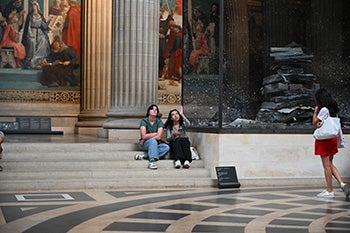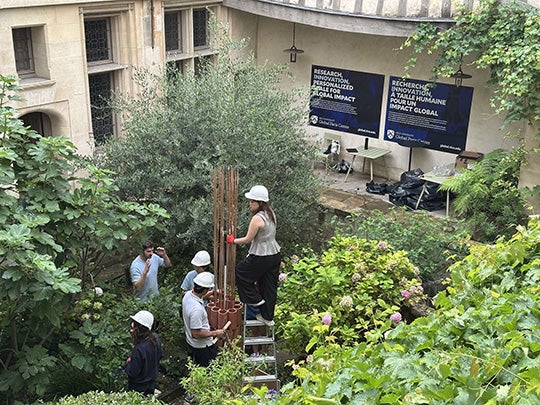Many civil infrastructure projects require interdisciplinary collaboration between civil engineers and architects. This summer, Rice University’s Kalil Erazo, assistant teaching professor in the Department of Civil and Environmental Engineering at the George R. Brown School of Engineering and Computing, and Juan José Castellón, assistant professor in the School of Architecture, co-taught a summer intensive program titled, "Architectural Structures | Structural Architectures" at the Rice Global Paris Center. The program aimed to demonstrate with real-world experiences the interconnectedness of the two disciplines to undergraduate students majoring in civil engineering and architecture.

This three-week, two-course program introduced students to the principles used in the design of civil and architectural structures from a multidisciplinary perspective. "The two disciplines are related and industry practitioners often collaborate and work closely together. So, we created this opportunity to introduce our students to concepts from both fields and taught them how to apply cross-disciplinary approaches to analyze historical and contemporary structures," said Erazo. "We used structures such as the Eiffel Tower, Maison Jaoul, Ville Savoye, Pompidou Paris & Metz, and the Louis Vuitton Foundation (among many others) as teaching laboratories."
The program covered various topics in civil engineering and architecture such as material behavior, force analysis, construction, resiliency, sustainability, and design considerations through lectures, field trips, and hands-on experiments on structural life cycle analysis, reducing greenhouse emissions, and recycling materials.
"We had joint lectures where Juan and I presented principles and concepts applied to the same structures and considered each discipline's contribution to the final design," Erazo said."What made the experience special was the opportunity to include design aspects from both professions as part of the lectures, and then having the opportunity to visit historical and contemporary structures right afterward to see how those theories have been put in practice. For example, one day we studied and analyzed some of the concepts used in the design of the Eiffel Tower in the morning, and then visited the structure in the afternoon to continue the discussion in the field. They learned about sustainable design principles, then walked through Frank Gehry's Louis Vuitton Foundation, examining how those theories manifested in contemporary architecture.”
Emphasizing immersive experiences and interdisciplinary collaborations
"I wasn't originally planning to study abroad during my time at Rice, but when I got the email about this opportunity, it seemed like the perfect fit for me," said Lucy Rixner, a rising junior in civil engineering. "Dr. Erazo and Dr. Castellon put great emphasis on learning directly from the city, and I really valued the experiences that I gained from exploring the city and viewing the structures and architecture firsthand."

This immersive approach was intentional. From its location in the heart of Le Marais, the Paris Center is designed to support courses that blend academic rigor with cultural exploration. Erazo's and Castellón's classes used that design, and often incorporated the city's architectural marvels into the syllabus.
"The students also had the opportunity to visit two world-renowned design firms, the Renzo Piano Building Workshop and the Kengo Kuma & Associates offices in Paris," Erazo explained.
Prior to the course, Rixner had limited exposure to Rice's architecture department aside from one class taken to fulfill a distribution requirement. Still, she quickly found herself drawn in by the course's interdisciplinary nature.
"This course opened my eyes to the similarities between civil engineering and architecture and allowed me to meet several architecture students who shared many of my passions, though with a different approach to problem solving," she said. "Collaborating with architecture students and learning about their perspectives on city projects and urban structures was fascinating."
Rixner said working alongside architecture students helped her see engineering concepts as more grounded in real-world applications and also infused them with cultural relevance.
Toson Aldam-Tajima, a rising sophomore in civil and environmental engineering, echoed this sentiment about interdisciplinary collaboration. "Prior to this program, I had had little interaction with the architecture students and the department in general," he said. "As soon as the course began, I immediately felt that the environment of the class was very conducive to connecting with the students from the other discipline. This allowed me to open them up to the beauty of engineering and have meaningful conversations with them about their work in architecture."

Aldam-Tajima described the experience as transformative, noting how both groups explored their intersection together. "As much as I learned technical and practical skills from the program, I must say that the most memorable times came from moments of humanity from both the professors and my peers as we worked our way through the complexities of living in a new city and sharing our passion for the beauty of the built environment," he said.
The course concluded with a hands-on workshop where students built a cooling tower prototype from scratch in the patio of the Rice Global Paris Center using local materials. This practical exercise combined all the theoretical concepts they had learned, requiring them to apply engineering principles and architectural design considerations.
Building deep connections in Paris
But for many, the most significant impact came from the small, personal revelations—those moments when engineering principles crossed into architectural appreciation and daily life.
"For me, some of the most memorable experiences in Paris were the group meals," Rixner said. "When we all sat down at the table together, professor and student alike, I really enjoyed my meal and was able to learn a lot. I really enjoyed being able to get to know the professors better and talk to them in a more casual setting than a typical interaction during the semester."

She noted how the group dynamics evolved throughout the program, "from all of us chattering excitedly and getting to know each other for the first time to reflecting on our experiences and laughing together for the last time we would all be with each other in the beautiful city of Paris."
The result was an academic transformation in how students understood engineering and approached collaborative design.
"I came out of this study abroad experience with several new friendships and a greater understanding of not just civil engineering, but also an appreciation for architecture," Rixner said, encouraging other civil and environmental engineering students in these disciplines to consider similar opportunities. "I'm glad I had this opportunity to expand my horizons, experience a different culture, and gain a more interdisciplinary view of urban design and the built environment."
In the summer of 2024, Erazo and Castellon conducted a similar interdisciplinary summer immersive course in Barcelona.

